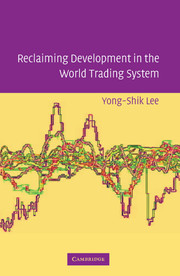Book contents
- Frontmatter
- Contents
- List of Abbreviations
- Acknowledgments
- 1 Poverty, Economic Development, and International Trade
- 2 Current Regulatory Framework for International Trade: The WTO System
- 3 Reclaiming Development: Tariff Bindings and Subsidies
- 4 Anti-Dumping and Safeguards
- 5 “Expansion” of Trade Disciplines and Development
- 6 Foreign Direct Investment and Regional Trade Liberalization
- 7 Conclusion: Putting Back the Ladder
- Epilogue
- Bibliography
- Index
4 - Anti-Dumping and Safeguards
Published online by Cambridge University Press: 18 August 2009
- Frontmatter
- Contents
- List of Abbreviations
- Acknowledgments
- 1 Poverty, Economic Development, and International Trade
- 2 Current Regulatory Framework for International Trade: The WTO System
- 3 Reclaiming Development: Tariff Bindings and Subsidies
- 4 Anti-Dumping and Safeguards
- 5 “Expansion” of Trade Disciplines and Development
- 6 Foreign Direct Investment and Regional Trade Liberalization
- 7 Conclusion: Putting Back the Ladder
- Epilogue
- Bibliography
- Index
Summary
Administered Protection
The WTO system authorizes the application of certain measures on trade, and this chapter discusses the effects of some of the major trade measures on development. Trade measures include a vast array of government measures that affect trade, frequently applied in the form of (increased) tariffs and quotas. Governments apply trade measures for various political and economic reasons. For instance, trade measures are an important instrument of infant industry promotion. Certain trade measures, such as AD measures, CVD measures, and safeguard measures, are called “administered protection” because they are applied for the protection of a specific domestic industry, and this protection is administered by the terms of the relevant WTO rules. Measures of administered protection are frequently applied and have significant ramifications on development. Because subsidy issues and CVD actions are already covered in the preceding chapter, this chapter discusses AD actions and safeguard measures.
Why do we allow governments to adopt measures of administered protection while the objective of the WTO system is to pursue open trade? The rationale for AD measures and CVD actions is rather different from that for safeguard measures: with respect to the former, the justification is found in the promotion of “fair trade.” Here, unfairly low prices (dumping), as well as a trade-related government subsidy, is believed to provide the exporters with an “unfair” advantage; therefore, the importing country has a right to offset this unfair advantage by applying counter-trade measures.
- Type
- Chapter
- Information
- Reclaiming Development in the World Trading System , pp. 82 - 106Publisher: Cambridge University PressPrint publication year: 2006



